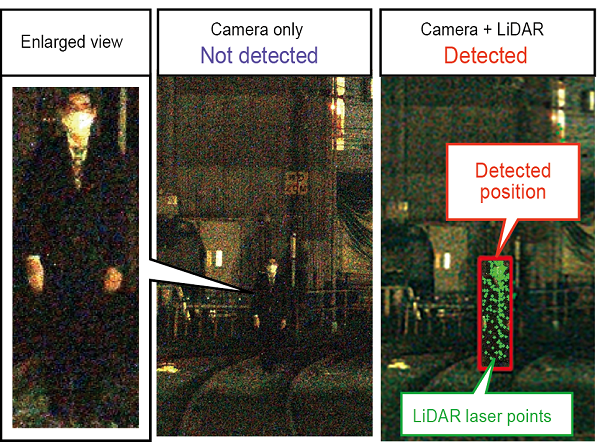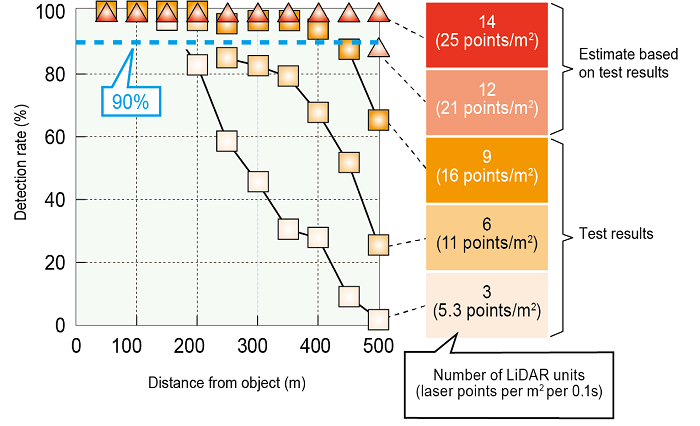10. On-board obstacle detection system suitable for low-light conditions
Normally when a driver sees an obstacle on the railway tracks, they slow the train or stop altogether. Automatic detection of objects in front of the train will reduce the driver workload and boost operational safety. Our obstacle detection system can be used to assist drivers in spotting obstacles on the railway tracks both during the day and at night.
We have previously developed AI-based systems for the identification of the human form and other objects in video images. However, these systems achieved a success rate of 95% or higher only at distances of up to 300 meters in daylight and performed less effectively at night.
In contrast, our newly developed system also utilizes AI for object identification in video images, but the incorporation of LiDAR data (laser reflections from objects) enables it to maintain performance in low-light conditions, including nighttime scenarios.
Figure 1 illustrates the functioning of our system for nighttime obstacle detection on railway tracks. It is evident that the LiDAR laser accurately identifies a person under conditions where a camera may fail. To assess the system's nighttime detection performance, we conducted tests using up to nine LiDAR units at different distances (see Figure 2).
Our findings indicate that when nine LiDAR units are connected, the system can identify individuals located 400 meters ahead with an accuracy exceeding 90%. Furthermore, increasing the number of LiDAR units enhances resolution, characterized by the number of laser points per unit area at the detection distance. With 14 units installed, the system can reliably detect individuals at distances of up to 500 meters during nighttime conditions, achieving close to 100% accuracy.
While our findings shown in Figure 2 are for distances of up to 500 meters, if newer LiDAR units with laser coverage beyond 500 meters were to become available, it will deliver further improvements in detection distances. Given that LiDAR units are compact (around 10 cm3) and relatively inexpensive (under ¥200,000), a system comprising ten or more LiDAR units is considered feasible in terms of size and cost. The obstacle detection system offers design flexibility, so that railway operators can choose the sensor configuration to suit their particular performance requirements.
Other Contents
- 9. Integrated analytics platform for railways
- 10. On-board obstacle detection system suitable for low-light conditions
- 11. Tool for estimating bridge deflection from on-board track irregularity measurements
- 12. Wear measuring apparatus for overhead conductor rail using light sectioning
- 13. Imaging analysis method for detecting various anomalies in overhead contact lines
- 14. Automated crew scheduling system
- 15. Fast-track embankment structure for confined settings
- 16. Numerical analysis method for predicting interaction impacts on closely adjacent tunnels
- 17. Method for evaluating girder vibration characteristics with consideration for track rigidity
- 18. Concrete repair methodology based on crack width and location
- 19. Using expansive concrete in track slabs to minimize reinforcement
- 20. Using temperature sensors to help predict service life of electronic signallingequipment
- 21. Effective and efficient steam weeding technique
- 9. Integrated analytics platform for railways
- 10. On-board obstacle detection system suitable for low-light conditions
- 11. Tool for estimating bridge deflection from on-board track irregularity measurements
- 12. Wear measuring apparatus for overhead conductor rail using light sectioning
- 13. Imaging analysis method for detecting various anomalies in overhead contact lines
- 14. Automated crew scheduling system
- 15. Fast-track embankment structure for confined settings
- 16. Numerical analysis method for predicting interaction impacts on closely adjacent tunnels
- 17. Method for evaluating girder vibration characteristics with consideration for track rigidity
- 18. Concrete repair methodology based on crack width and location
- 19. Using expansive concrete in track slabs to minimize reinforcement
- 20. Using temperature sensors to help predict service life of electronic signallingequipment
- 21. Effective and efficient steam weeding technique


